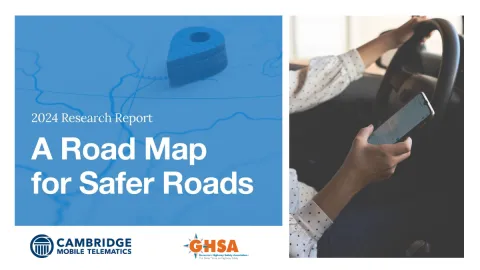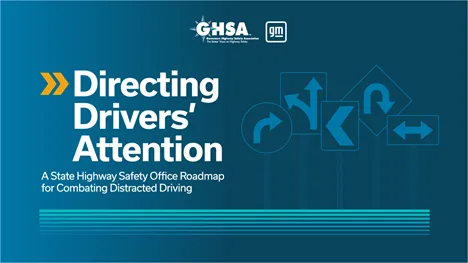Distracted Driving


Driver distraction – which includes eating, drinking, grooming, day-dreaming, talking and texting on handheld devices and many other actions that take a motorist’s eyes and mind off the road – is a contributing factor in many crashes despite many instances going unreported. In 2023, 3,275 people died and another 324,819 were injured in distraction-related crashes (Distracted Driving in 2023, National Highway Traffic Safety Administration [NHTSA]. That's an average of nine deaths and 890 injuries due to distracted driving every single day.
At any given moment during daylight hours, more than 326,000 U.S. drivers – half the population of the state of Vermont – are holding a cell phone to their ear while driving (Driver Electronic Device Use in 2023, NHTSA).
Phone use while driving – particularly calling and texting – is one of the most common distractions. When a person reads a text while driving, his or her eyes are off the road for an average of five seconds. At 55 miles per hour, that is like driving the length of an entire football field while blindfolded.
Many states and local jurisdictions have passed laws that address these behaviors. GHSA's message to all drivers is simple: Don't use cellphones or other electronic devices while driving, regardless of the current law. Keep your hands on the wheel and your eyes and mind on the road.
Nearly every state has passed some sort of statewide law against distracted driving, but more states are adopting new hands-free distracted driving laws that account for new technology and clearly state when and how a driver can or cannot use an electronic device behind the wheel.
GHSA recommends that states prohibit handheld cellphone use by all drivers. Although texting and handheld bans are both critical, texting bans alone can be difficult to enforce. In states with texting only bans, drivers may claim they were only dialing when stopped by a police officer. Enforcement demonstration projects in New York, Connecticut, Delaware and California have shown that handheld cellphone bans can be enforced effectively and reduce driver use of a cellphone.
While law enforcement plays a vital role in reducing distracted driving crashes, injuries and fatalities, it is critical that state laws be equitably applied regardless of race, nationality, gender, sexuality, or any other unique characteristics.
In 2024, GHSA and Cambridge Mobile Telematics released a report, A Road Map for Safer Roads, that details how distracted driving has fallen in states like Ohio, Alabama, Michigan, and Missouri after they implemented hands-free laws. These results underscore the effectiveness of legal frameworks in enhancing road safety. The report also discusses how incentive-based programs such as "Safest Driver," powered by CMT technology, are motivating drivers to refrain from engaging in risky driving behaviors leading to a reduction in crashes.

In 2022, GHSA collaborated with General Motors to produce a report, Directing Drivers’ Attention: A State Highway Safety Office Roadmap for Combating Distracted Driving, which offers one of the most comprehensive looks at this pervasive yet preventable traffic safety problem and urges a broad culture shift to make this deadly behavior socially unacceptable. The report examines data shortcomings and other obstacles impacting efforts to reduce distracted driving, and reviews State Highway Safety Office (SHSO) initiatives and the challenges impacting those efforts. It also provides 29 action-oriented recommendations for the SHSOs that cover a wide range of factors that affect distracted driving, including state laws, data collection, education and public outreach, enforcement, infrastructure, safety funding sources, partnerships, and leadership.

In 2021, GHSA and the Transportation Research Board’s Behavioral Traffic Safety Cooperative Research Program (BTSCRP) issued a research report that reviewed distracted driving laws, enforcement and public education practices across the United States and Canada to develop a library of resources and best practices that states and other stakeholders can use to enact or revise their laws and enhance enforcement and education efforts (Using Electronic Devices While Driving: Legislation and Enforcement Implications, Transportation Research Board, National Academies of Sciences, Engineering, and Medicine).
Researchers found that the most effective laws and state safety efforts had the following common elements:
Some localities have additional regulations. Enforcement type is noted under individual state data.
Crash Data Collection: All states except two (Connecticut and New Hampshire) include at least one category for distraction on police crash report forms, although the specific data collected varies.
Preemption Laws: Some states have preemption laws that prohibit local jurisdictions from enacting their own distracted driving bans. States with such laws include — but may not be limited to — Florida, Iowa, Kentucky, Louisiana, Mississippi, Nevada, Pennsylvania, Oklahoma, Oregon and South Carolina.
NOTE: GHSA does not compile any additional data on distracted driving laws other than what is presented here. For more information, consult the appropriate State Highway Safety Office.
Sources: Insurance Institute for Highway Safety (IIHS) and State Highway Safety Offices (SHSOs).
Last updated in October 2025. Laws last reviewed by SHSOs in June 2025.
Between 2011 and 2020, the percentage of drivers observed visbily manipulating a handheld device went up, according to the National Center for Statistics and Analysis, an office of the National Highway Traffic Safety Administration (NHTSA).
